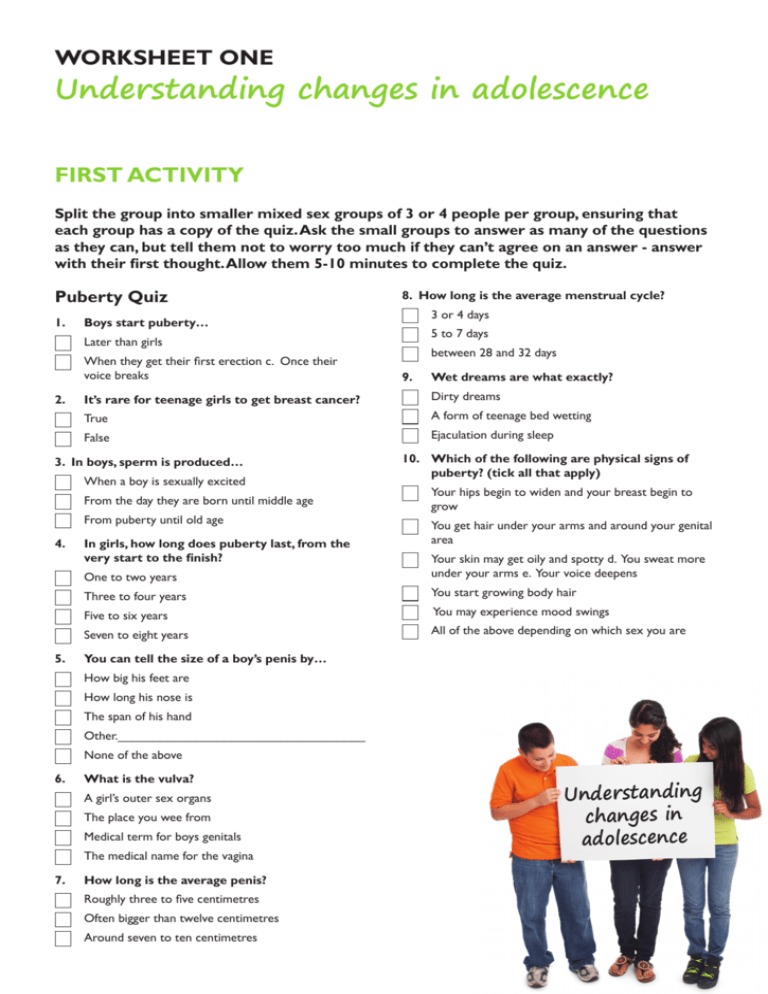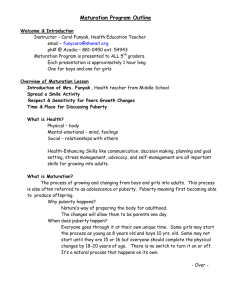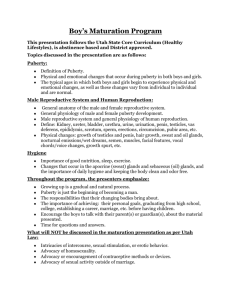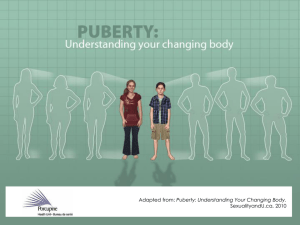Understanding changes in adolescence
advertisement

WORKSHEET ONE Understanding changes in adolescence FIRST ACTIVITY Split the group into smaller mixed sex groups of 3 or 4 people per group, ensuring that each group has a copy of the quiz. Ask the small groups to answer as many of the questions as they can, but tell them not to worry too much if they can’t agree on an answer - answer with their first thought. Allow them 5-10 minutes to complete the quiz. Puberty Quiz 1. 8. How long is the average menstrual cycle? 3 or 4 days Boys start puberty… 5 to 7 days Later than girls When they get their first erection c. Once their voice breaks 2. It’s rare for teenage girls to get breast cancer? Wet dreams are what exactly? Dirty dreams A form of teenage bed wetting False Ejaculation during sleep When a boy is sexually excited From the day they are born until middle age From puberty until old age 5. 9. True 3. In boys, sperm is produced… 4. between 28 and 32 days In girls, how long does puberty last, from the very start to the finish? 10. Which of the following are physical signs of puberty? (tick all that apply) Your hips begin to widen and your breast begin to grow You get hair under your arms and around your genital area One to two years Your skin may get oily and spotty d. You sweat more under your arms e. Your voice deepens Three to four years You start growing body hair Five to six years You may experience mood swings Seven to eight years All of the above depending on which sex you are You can tell the size of a boy’s penis by… How big his feet are How long his nose is The span of his hand Other.___________________________________ None of the above 6. What is the vulva? A girl’s outer sex organs The place you wee from Medical term for boys genitals The medical name for the vagina 7. How long is the average penis? Roughly three to five centimetres Often bigger than twelve centimetres Around seven to ten centimetres Understanding changes in adolescence Puberty Quiz Answers Sheet 1. Later than girls On average boys start puberty later than girls, however everybody develops at different rates and times, so do not worry if your friend is further developed than you. becoming an adult. It is about learning about you and accepting those changes without comparing yourself to others. Everybody is different and puberty for everybody is different, including the times at which it happens. Information: Puberty starts: For girls - usually between the ages of 10 and 16 5. None of the above, despite what you may hear. For boys - usually between the ages of 12 and 16 Some people start puberty earlier and some later everyone is different. 6.This is the name for girl’s outer sex organs, including the labia, clitoris and vagina. 2. True. However girls do need to check themselves for breast lumps and boys should also get in the habit of checking their testicles for lumps. 7. Again despite what you may have heard or think the average penis size is seven and ten centimetres, some are larger and some smaller, but size does not affect the ability to enjoy a good sex life or produce children. Information: Cancer Breast cancer is rare in young teenage girls; however they should start examining their breast for lumps and changes in structure (other than that which happens during puberty). Testicular cancer is also rare in young boys, however it can occur from the age of 14-40 years and boys should also be checking their testicles for lumps. 3. Sperm is produced from puberty until old age and it takes about 2 weeks for sperm to mature, but don’t worry. Information: Sperm production. Sperm is a very tiny male sex cell and is needed to fertilize a woman’s egg (ovum) They are made up of three parts, the head, the midpiece and the tail which they use to swim from the vagina to the uterus 8. Between 28 - 32 days.The menstrual cycle is not only where girls/women have a period bleed, it covers the time from the end of one period until the end of the next period. It is possible for a pregnancy to occur anytime during the menstrual cycle but it is more likely at certain times in the cycle. Information: Periods. (the menstrual cycle) The menstrual cycle is from the first day of a period until the day before the next period starts and can vary in length from as little as 21 days to as long as 40 days Girls are born with about a quarter of a million eggs in each of their ovaries Sperm swim about 3mm per hour! And need to wave their tails more than 1000 times to swim 1.25cm Hormones make the eggs mature and also thicken the lining of your womb, usually one egg becomes larger and is released into the fallopian tube that connects to the ovary Sperm are made in the testes where it takes about 72 hours for one sperm to be made This release of the egg is called ovulation and it happens around 14 days before a period is due. •Sperm production needs to be 3-5 degrees below body temperature which is why the testicles are inside the scrotum and hang away from the body when warm, or move closer to the body when cold. If the egg is not fertilised it will die and hormone levels drop. Without these hormones the womb lining which thickened during ovulation, breaks up and with the egg, is released through the vagina as a period. 4. Seven to eight years, but again some people develop earlier or later than others, so you shouldn’t worry if your breasts are still growing or you haven’t started your period yet. 9. Ejaculation during sleep: while this may be embarrassing there is nothing you can do to prevent them. Many boys/men have wet dreams, don’t worry too much as many fathers have gone through this themselves when they were growing up. Information: Puberty Due to the body changes and development which occurs during puberty it can sometimes cause concerns around body image and raise the question ‘am I normal?’ Everybody develops at different times and different rates. Puberty is the transformation from being a child and 10. All of the above and other changes as well; you may wish to stress that it is not only girls who have mood swings - boys tend to get them as well. (Instead you may wish to ask the group for any further ideas). WORKSHEET TWO Understanding changes in adolescence SECOND ACTIVITY Once the groups have completed the quiz, go through the questions with them and have them feedback their answers before you provide them with the correct answers and address any issues raised. This is a session which allows many of the myths concerning puberty to be addressed by using some of the information, resource photos and images provided. Understanding changes in adolescence WORKSHEET THREE Understanding changes in adolescence All three of these young men are nearly 13 years old but their bodies are developing at different rates. Understanding changes in adolescence WORKSHEET FOUR Understanding changes in adolescence All three of these young women are nearly 13 years old but their bodies are developing at different rates. Understanding changes in adolescence WORKSHEET FIVE Understanding changes in adolescence Your Monthly Testicular Self Examination Guide SAMPLE It is best to examine your testicles after a warm bath or shower when the heat relaxes the skin making examination easier. Using a mirror look for any swelling or change in size, bearing in mind that it is common for one testicle to hang slightly lower than the other. Understanding Next examine each testicle in turn. Using both hands, gently roll the testicle betweench the anges in thumbs and fingers, you will find a hard ridge on top of the testicle - this is normal. You adolescence are checking for any lumps, irregular swellings or change in firmness. If you have any warning signs see your doctor Teacher notes/guidelines: This is a workshop where open honest answers work really well, as it is one of those areas that everybody goes through, but few people talk about. Sometimes it is an idea to give the students the opportunity to ask questions via an anonymous slip of paper, this often results in some very good questions which could be prepared in a prior tutor group or written by the students during the session. If the students appear worried about passing in questions just hold up some bits of folded paper and inform them that you have already been given some questions (Use Puberty Resource Questions Sheet) and mix them up with any further questions. Assessment: This is often best done in the form of a review of the topics covered. Assessment can also be done via homework/project assignments around puberty. Method of and closing the session: The students will be aware that puberty happens to everybody, but by simply reassuring them that it happens to different people at different times and that this is normal will comfort them, remind them that during puberty they will be changing in body size and also emotionally and that often by talking to a close friend or a parent helps if you’re concerned. Useful Hints The topic of this workshop is one which some students will find hard to discuss. It is a workshop where whilst everybody may not fully interact, everybody does tend to listen and absorb what is being said. This is a topic that many parents/casrers find hard to speak to their own children about, so often the students will take the opportunity to ask the questions they can’t or won’t ask their parents/carers. The workshop is best if run as a relaxed interactive session with the students answering the questions themselves and the staff member only correcting small bits of information as necessary. This in itself promotes communication amongst the students about sensitive and emotional issues. Notes: Notes: There is often a lot of embarrassment around puberty, coupled with body image issues and self-esteem issues, both of which feature heavily in bullying. For this reason the class working agreement must obtain a clause in which the students agree not to divulge any information that they would not want anyone outside the classroom to know about as confidentiality can not be guaranteed. It is also important for students to know where they can go to get support and guidance if they are worried - This must also include talking to parents / carers. Understanding changes in adolescence




